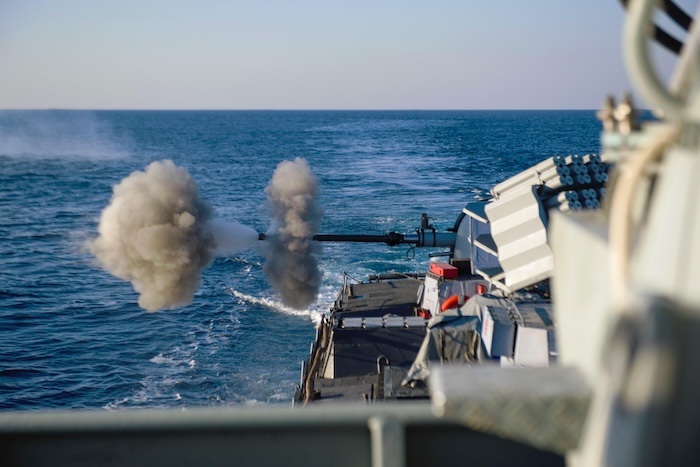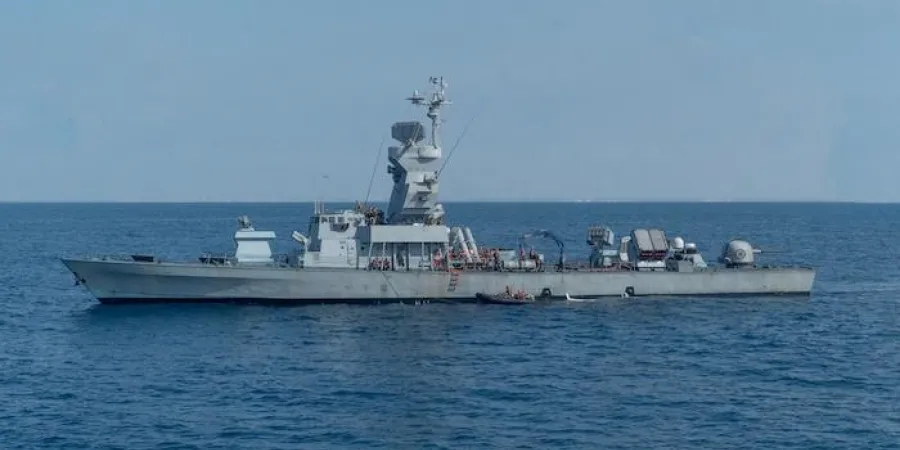Iron Waves: Israel's Missile Boat Flotilla in Action
Gaza Strip from the West, from sea. I can see everything from the missile boat,” says Lieutenant Colonel Steven, a Shayatet 3 division commander, in a special interview
Dan Arkin
| 08/02/2024
The Israeli Navy defines three missions for its missile boat flotilla, known as the Flotilla 3 (“Shayetet 3” in Hebrew): to fight the enemy at sea, to prevent a naval blockade on the State of Israel, and to assist ground forces in sea-based attacks.
The missile boats fulfilled the third mission from the outset of the Swords of Iron War, and the task has not yet been completed. They are still at sea, patrolling off the Gaza Strip’s shores – as well as off Israel’s northern coast and the Red Sea.
Lieutenant Colonel Steven, a division commander in Flotilla 3, prepared to celebrate the holiday of Simchat Torah with his family on October 7th, but then the phone rang at 06:45 am. He hurried to the flotilla’s naval base and set sail, initially with two out of the five ships in the flotilla he commands. His unit comprises four Sa’ar 4.5-class missile boats and a detection ship tasked with underwater threat detection and maritime rescue missions.
In Flotilla 3, there are currently 15 Sa’ar missile boats – 4.5, 5, and 6-class, the newest model. Lieutenant Colonel Steven formerly commanded a Sa'ar 6-class ship, and also brought INS “Victory” to Israel from the shipyard in Germany.
"The Sa'ar 4.5-class missile boats are equipped with the 6-class capabilities, except for a helicopter on the deck,” Lieutenant Colonel Steven tells Israel Defense. “The ship is armed with a 76mm cannon, a 25mm Typhoon cannon, offensive and defensive capabilities, EL/M systems, and anti-submarine systems. Most of the weapon systems are made by Israeli industries, except for the 76mm cannon, which is manufactured by the Italian company Oto Melara.
“A Sa’ar 4.5-class missile boat has between 60 to 90 crew members, depending on the mission. The manpower on the ship is divided into four sectors: weapons and offense, navigation, defense, and machinery. All crew members are regular and permanent army personnel, and in the current war, we have deployed a small number of reservists to bolster the arrays.”
In the early days of the war, the boats under Steven's command were tasked with defensive missions using fire, primarily to deter terrorists from approaching IDF forces. However, very quickly, the naval force shifted from defense to offense. Lieutenant Colonel Steven remarked, 'We have been at war and at sea for four months now, and three weeks after the start of the fighting, we joined the battle with a dual mission: surveillance and fire.”
“Our surveillance capabilities hold great importance, as only we can view the Gaza Strip from the west, from the sea. From the missile boat, I can see everything. I observe people in motion as the boat patrols off the coast, seeing both the enemy and our forces. Even in bad weather conditions, especially now in winter, our surveillance remains effective because all systems are stabilized even when the ship sways. The systems are fixed relative to the horizon.
The primary mission of the Navy in the current war is providing fire support, and this support is being executed on an unprecedented scale in the history of the force. Steven explains, “Only I (we) can fire from the west at terrorist targets in the Gaza Strip. During the firing, like in the entire IDF, we are careful not to harm uninvolved civilians; the fire is accurate and effective.”
When the cannons fire, there is no one on deck. All the cannons are remotely controlled from command positions. The vessels themselves are unmanned. It cannot be said that there is no risk of fire on naval vessels, but we know how to defend ourselves, and so far, since the beginning of the war, there have been no casualties in the flotilla.

Photo: IDF Spokesperson's Unitt
The flotilla is integrated into the war effort with multi-branch cooperation, as is evident across all branches of the IDF. When a crewmember identifies terrorists, they can call a “Zik” (Hermes 450) drone or another drone to attack a target identified on the shore.
"I am in communication with the commander of the ground forces,” Steven says. “I can pinpoint his fire due to my surveillance capabilities, and he pinpoints my fire from the boat because he is close to the target. This way, a missile boat can assist in clearing an area and securing it from militant presence."
The commander testifies that over the years, both in the flotilla and in the Navy, there has been precise coordination on the topic of multi-branch and inter-branch integration, and in the war, this issue has come to operational assurance.
Lieutenant Colonel Steven is 39 years old, a father of four daughters and a resident of Netanya, who has spent his entire military career in Flotilla 3, holding various positions. He commands his team, the young soldiers. “This is an exceptional young generation. They are highly professional, they’re not spoiled and don’t complain. They maintain their fighting and team spirit also in long and difficult voyages, and rise up to the challenges.
I asked Steven what Gaza City looks like from the sea. “There isn’t full destruction, there are homes and buildings there – alongside areas that were severely damaged,” he says. “We even saw Gaza children playing in the water.”
Gaza Strip from the West, from sea. I can see everything from the missile boat,” says Lieutenant Colonel Steven, a Shayatet 3 division commander, in a special interview
The Israeli Navy defines three missions for its missile boat flotilla, known as the Flotilla 3 (“Shayetet 3” in Hebrew): to fight the enemy at sea, to prevent a naval blockade on the State of Israel, and to assist ground forces in sea-based attacks.
The missile boats fulfilled the third mission from the outset of the Swords of Iron War, and the task has not yet been completed. They are still at sea, patrolling off the Gaza Strip’s shores – as well as off Israel’s northern coast and the Red Sea.
Lieutenant Colonel Steven, a division commander in Flotilla 3, prepared to celebrate the holiday of Simchat Torah with his family on October 7th, but then the phone rang at 06:45 am. He hurried to the flotilla’s naval base and set sail, initially with two out of the five ships in the flotilla he commands. His unit comprises four Sa’ar 4.5-class missile boats and a detection ship tasked with underwater threat detection and maritime rescue missions.
In Flotilla 3, there are currently 15 Sa’ar missile boats – 4.5, 5, and 6-class, the newest model. Lieutenant Colonel Steven formerly commanded a Sa'ar 6-class ship, and also brought INS “Victory” to Israel from the shipyard in Germany.
"The Sa'ar 4.5-class missile boats are equipped with the 6-class capabilities, except for a helicopter on the deck,” Lieutenant Colonel Steven tells Israel Defense. “The ship is armed with a 76mm cannon, a 25mm Typhoon cannon, offensive and defensive capabilities, EL/M systems, and anti-submarine systems. Most of the weapon systems are made by Israeli industries, except for the 76mm cannon, which is manufactured by the Italian company Oto Melara.
“A Sa’ar 4.5-class missile boat has between 60 to 90 crew members, depending on the mission. The manpower on the ship is divided into four sectors: weapons and offense, navigation, defense, and machinery. All crew members are regular and permanent army personnel, and in the current war, we have deployed a small number of reservists to bolster the arrays.”
In the early days of the war, the boats under Steven's command were tasked with defensive missions using fire, primarily to deter terrorists from approaching IDF forces. However, very quickly, the naval force shifted from defense to offense. Lieutenant Colonel Steven remarked, 'We have been at war and at sea for four months now, and three weeks after the start of the fighting, we joined the battle with a dual mission: surveillance and fire.”
“Our surveillance capabilities hold great importance, as only we can view the Gaza Strip from the west, from the sea. From the missile boat, I can see everything. I observe people in motion as the boat patrols off the coast, seeing both the enemy and our forces. Even in bad weather conditions, especially now in winter, our surveillance remains effective because all systems are stabilized even when the ship sways. The systems are fixed relative to the horizon.
The primary mission of the Navy in the current war is providing fire support, and this support is being executed on an unprecedented scale in the history of the force. Steven explains, “Only I (we) can fire from the west at terrorist targets in the Gaza Strip. During the firing, like in the entire IDF, we are careful not to harm uninvolved civilians; the fire is accurate and effective.”
When the cannons fire, there is no one on deck. All the cannons are remotely controlled from command positions. The vessels themselves are unmanned. It cannot be said that there is no risk of fire on naval vessels, but we know how to defend ourselves, and so far, since the beginning of the war, there have been no casualties in the flotilla.

Photo: IDF Spokesperson's Unitt
The flotilla is integrated into the war effort with multi-branch cooperation, as is evident across all branches of the IDF. When a crewmember identifies terrorists, they can call a “Zik” (Hermes 450) drone or another drone to attack a target identified on the shore.
"I am in communication with the commander of the ground forces,” Steven says. “I can pinpoint his fire due to my surveillance capabilities, and he pinpoints my fire from the boat because he is close to the target. This way, a missile boat can assist in clearing an area and securing it from militant presence."
The commander testifies that over the years, both in the flotilla and in the Navy, there has been precise coordination on the topic of multi-branch and inter-branch integration, and in the war, this issue has come to operational assurance.
Lieutenant Colonel Steven is 39 years old, a father of four daughters and a resident of Netanya, who has spent his entire military career in Flotilla 3, holding various positions. He commands his team, the young soldiers. “This is an exceptional young generation. They are highly professional, they’re not spoiled and don’t complain. They maintain their fighting and team spirit also in long and difficult voyages, and rise up to the challenges.
I asked Steven what Gaza City looks like from the sea. “There isn’t full destruction, there are homes and buildings there – alongside areas that were severely damaged,” he says. “We even saw Gaza children playing in the water.”



